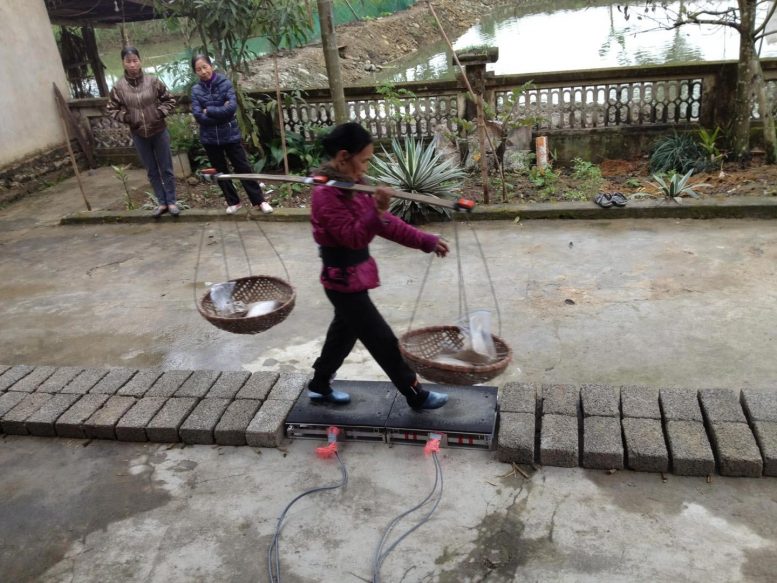
A woman carrying a heavy load on a flexible bamboo pole walking on a force plate. Credit: Bertram Lab, University of Calgary
Carrying heavy loads on a flexible bamboo pole allows walkers to save up to 20% of their energy.
Southeast Asia is a riot of color and biodiversity. Boasting luxuriant rainforest and thousands of insects and mammals, the region is ripe for a biologist in search of inspiration. But when James Croft, then at Edith Cowan University, Australia, went traveling, it wasn’t the flora and fauna that caught his eye: it was the villagers carrying massive loads, sometimes more than their own body weight, on a bouncy bamboo pole slung across a shoulder.
‘I was curious how that evolved,’ says Croft, adding, ‘I wondered if the springiness of the poles allowed them to transport the load more efficiently.’ However, he also knew that the benefits of carrying loads on flexible poles was a bone of contention; some studies suggested the poles are beneficial, while others did not. Croft realized that many of the previous investigations had been carried out with pole-carrying novices, whereas the villagers that he had observed were true professionals, sometimes with decades of experience.
After discussing the problem with John Bertram from the University of Calgary, Canada, Croft decided to return to Vietnam to find out whether experienced flexible pole carriers adapt the way they walk to help them carry heavy loads. The team published their discovery that villagers carrying a heavy load on a flexible pole could use 20% less energy than when using a rigid pole in Journal of Experimental Biology, today (December 4, 2019.)
‘The travel to Vietnam was both exciting and challenging,’ says Ryan Schroeder, also from Calgary, describing how the trio drove near to the southern Chinese border after flying to Hanoi. ‘We made contact with the Thái Nguyên University of Medicine and Pharmacy and met Van Son Nguyen and Van Vinh Hac. Then we hired a translator who put us in touch with individuals who had experience using bamboo poles,’ says Schroeder. Having recruited 14 volunteers, ranging in age from 18 to 80 years, the team asked them to walk along a 20m (66f) path carrying loads ranging from 0% to 50% of their body weight on their own personal bamboo pole and a rigid version. The researchers then measured the volunteers’ movements with accelerometers placed on their ankles, lower back, and the poles. ‘One participant, who happened to be the oldest, was slightly offended when we only asked him to carry half of his body weight of approximately 23kg (51lb),’ smiles Schroeder.
Back in Calgary, Schroeder analyzed the volunteers’ motions and realized that the villagers were subtly adjusting their stride by 3.3% (0.067 steps/s) when carrying half of their body weight on a flexible bamboo pole: ‘It doesn’t sound like much, but it’s significant,’ says Schroeder. And when he built a computer simulation of the walkers and calculated the contribution of the poles’ flexibility to their walking efficiency, he realized that the walkers moved with less effort when slightly offsetting their stride from the natural bounce of their individual bendy bamboo poles.
The simulation also predicted that walkers carrying their own body weight on a flexible pole would save almost 20% of their energy compared with using a rigid pole. In addition, the bendy bamboo pole saved their shoulders more, by reducing the forces exerted on them by 18% when transporting half of their body weight, allowing them to carry incredibly heavy loads for kilometers at a time.
It seems that we could learn a lot from Asian villagers who have been using bamboo poles to carry heavy burdens for hundreds, if not thousands of years. ‘These remarkable yet simple tools can potentially reduce energetic exertion and lessen sharp forces on the carrier,’ says Schroeder, who is trying to implement some of the lessons in novel backpack design. ‘Westerners are only just beginning to catch on to this innovation,’ he smiles.
Reference: “Load carrying with flexible bamboo poles: optimization of a coupled oscillator system” by Ryan T. Schroeder, John E. A. Bertram, Van Son Nguyen, Van Vinh Hac and James L. Croft, 4 December 2019, Journal of Experimental Biology.
DOI: 10.1242/jeb.203760









Using a springy pole is almost as efficient as carrying the load balanced on the head.
I read a study on head loads and was assuming the researchers would compare the methods, energy saved versus training time as head load balancing is more efficient but harder to learn.